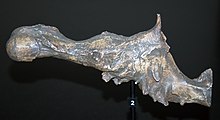Endocast
Endocasts of the inside of the neurocranium (braincase) are often made in paleoanthropology to study brain structures and hemispheric specialization in extinct human ancestors.
The openings to the brain cavity, except for the foramen magnum, are closed, and the liquid rubber is slushed around in the empty cranial vault and then left to set.
However, scientists are increasingly utilizing computerized tomography scanning technology to create digital endocasts in order to avoid risking damage to valuable specimens.
[6] Several hundred casts of various dinosaurs are known, among them a Tyrannosaurus brain vault, showing the animal had limited intelligence and a well-developed sense of smell.
[10] Endocasts are also known to develop from snail shells and sea urchins, and even from the stomach hollow of jellyfish, a group that rarely leaves fossil traces.



